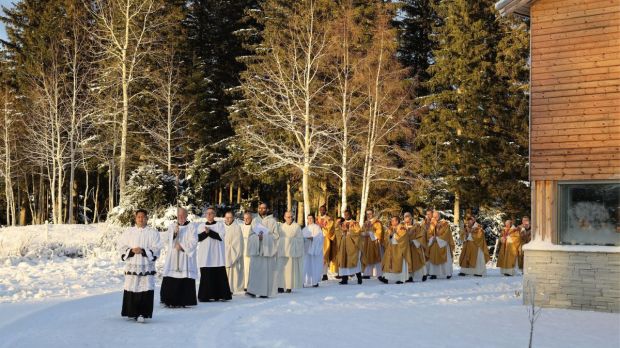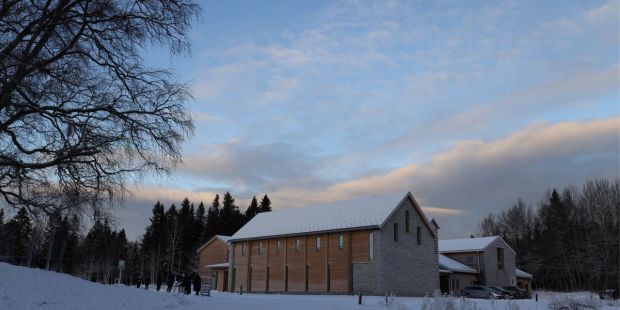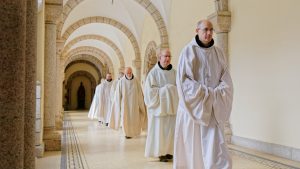It’s an enchanting place, where the Norwegian Sea extends its blue arm to the snow-capped mountains. And it’s here, on the fjord of Trondheim in Munkeby, that four monks from the Cistercian congregation of the Strict Observance (Trappists) consecrated the church of their new monastery at the end of 2023. Fr. Joseph, Fr. Joël, and Brs. Bruno and Arnaud settled on the Norwegian coast in 2009, returning to the site of the ruins of the former Cistercian monastery built in the 12th century, Munkeby Mariakloster.
“Until last Easter, we lived in a house with a small chapel,” Fr. Joël told Catholic News Agency (CNA). “After a while, we had to think about something bigger for the future. So we began construction of the monastery and church in 2021.” The newly-built wood and stone church is dedicated to the Virgin Mary and can accommodate 40 people.
The new monastery is located within walking distance of the ruins of the original Cistercian monastery. “The first time I saw it I thought to myself that this was a typical Cistercian place,” Fr. Joël told the National Catholic Register (NCR). “The entire place is a small shrine. It’s a mostly uninhabited and peaceful place, with a lot of silence and beautiful surroundings.”
True to its commitment to welcoming pilgrims and travelers, the community has also opened its guest house, with six rooms.
The consecration took place in the presence of 80 faithful, and the Mass was presided over by Bishop Erik Varden of the Prelature of Trondheim, himself a Trappist. He also performed the rite of blessing the church walls and altar, against a backdrop of snow. Relics were placed in the altar, on which the bishop then poured chrism in five places, symbolizing Christ’s wounds, before burning incense in the same places.
Click below to see a slideshow of the ceremony
A discreet presence
The idea of exporting the Cîteaux community to Norway germinated in the mind of Fr. Joël Regnard during an extended stay there with Trappist nuns, present in the area since 1999. “I providentially met a sister from Tautra Abbey during a formation session in France,” he told the NCR, “and she invited me to come to Tautra for my six-months sabbatical.”
Four monks, three from France and one from Ireland, were eventually sent. “In the region, we’re quite discreet, and that’s what’s needed,” says Fr. Joël to CNA. “Norwegians are very reserved people, so we cannot arrive here as conquerors to convert them, and that’s not our style. People know that they can come and pray, find a little peace and quiet, or take part in our services, as they wish.”
The Cistercian monks’ motto is “Ora et labora.” Along with the Benedictines, they follow the rule of St. Benedict. They are one of the leading contemplative orders, living cut off from the world to devote themselves entirely to prayer. Manual labor plays a particularly important role in the lives of these monks, who live by the work of their hands along with the donations they receive.
The origins of this monastic community date back to 1098, when St. Robert de Molesmes founded the abbey of Cîteaux. St. Bernard of Clairvaux was responsible for the Order’s development in the Middle Ages, ensuring its presence throughout Western Europe.
The return of Trappist monks to Norway “bears witness to the presence of God in a hyper-secularized society,” Fr Joël tells CNA. Only 3% of Norwegians are Catholics, most of the population being Lutheran. Like all Scandinavian peoples, Nordic paganism long held sway in Norway, before the Christianization of King Olav II.
Fr. Joël told the NCR that several young men have already visited the monastery to discern a possible vocation to join them. Other locals “have changed their view on the Catholic Church.”



